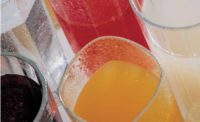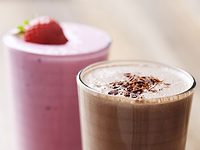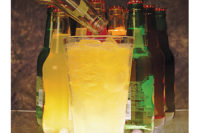When playing Jenga, players have to carefully remove small wooden blocks to simplify a tower’s structure without pulling out the wrong block, which can cause the tower to topple. In some ways, formulating beverages is like playing a game of Jenga: Formulators add and remove certain elements to simplify beverage processing or meet consumer interests; however, if they pull out the wrong ingredient, the beverage’s structure can fall apart. Fortunately for formulators, hydrocolloids can be used as a patch to fill in the holes and hold the structure together.
In trying to create healthier beverages for consumers, beverage-formulators might reduce or remove sugars and fat, but this could have repercussions on the final product. “When formulators start taking out sugars or fat, you lose some texture and mouthfeel,” says Aida Prenzno, director of technology at Gum Technology, a Tucson, Ariz.-based subsidiary of Penford Food Ingredients.
This situation is particularly common in low-caloric juice and sparkling beverages, notes Wen J. Shieh, technical leader in fruit, beverage and confection for the texturing solution business unit of Minneapolis-based Cargill. “Sugar provides good mouthfeel for the regular-caloric beverage,” he says. “When it is removed from the formulation, the beverage will not have the same viscosity, and the mouthfeel will be similar to plain water.” In these products, hydrocolloids like pectin, gum arabic or cellulose derivatives are used to improve the mouthfeel by adding lubricity and helping the drink to more closely replicate a full-calorie beverage, he says.
At the same time, hydrocolloids can help beverage-makers save money in fruit juice formulations, says Sean McHenry, technical service representative at Atlanta-based CP Kelco. By reducing the juice content and instead including hydrocolloids, which tend to require low usage levels, beverage-makers still can achieve a mouthfeel similar to that of a 100 percent juice, he says.
This texturizing property also has been important in the ready-to-drink and instant protein drinks segment, says Tim Andon, business development manager for TIC Gums, White Marsh, Md. “We are seeing an influx of protein drinks marketed to a wider array of consumers beyond traditional body builders and professional athletes,” he explains.
While athletic consumers are more interested in the protein beverage’s health benefits and less concerned about its off-taste or gritty, sandy mouthfeel, other consumers entering the segment have different mouthfeel expectations for their beverages and are averse to such textures, according to TIC Gums’ video “Instant Protein Beverages – Solving Texture Issues.” “In protein beverages, the increased amount of perceivable particulates resulting from the added vitamins, fiber and protein, as well as an increase in astringency, are factors that produce an aversion, rather than an attraction, to the beverage,” according to the video. “Improving taste alone will not rectify these issues.”
To deliver a smooth mouthfeel that appeals to a wider range of consumers, beverage-makers turn to hydrocolloid systems. For these applications, TIC Gums offers Ticaloid Ultrasmooth, a cold-water-soluble hydrocolloid system. In sensory panel evaluations, TIC Gums compared protein beverages containing different hydrocolloids, namely Ticaloid Ultrasmooth hydrocolloid system; xanthan gum, a single hydrocolloid ingredient; and a control group that did not contain hydrocolloids. The results showed that the beverages containing hydrocolloids offered increased viscosity, decreased astringency, higher slipperiness, and improved mouth clearing compared with the control. In addition, panelists were significantly less aware of particulates in the Ticaloid Ultrasmooth beverage than in the other samples, the company says.
Single hydrocolloid ingredients also have important applications in the beverage market. Gellan gum, a water-soluble polysaccharide, is commonly used to create a fluid gel suspension network for juice drinks, neutral protein drinks and alternative milks, CP Kelco’s McHenry notes. Pectin, a fruit- and vegetable-based gelling agent, is used to improve mouthfeel in juice and other low-pH beverages and for protein stability in low-pH protein drinks, he says. In addition, carrageenan, an algae-based hydrocolloid ingredient, is the primary stabilizer for most neutral-pH dairy applications, while xanthan gum and cellulose are used to provide additional body, mouthfeel and viscosity to a variety of beverages, he notes. CP Kelco offers patented versions of these hydrocolloids as Kelcogel Gellan gum, Genu Pectin, Genulacta Carrageenan, Keltrol Xanthan gum and Cekol Cellulose gum.
This wide range of applications for the various hydrocolloids, as well as hydrocolloid systems, has kept the hydrocolloid market trending upward. “Each year, thousands of new beverage products are launched to the market, most of them including at least one kind of hydrocolloid,” says Luis Ferrey, beverage marketing manager at Ingredion Inc., Westchester, Ill. Acidified protein drinks, such as fruit juice and milk- or yogurt-based beverages, alternative milks, and juice drinks tend to be the highest users of hydrocolloids, CP Kelco’s McHenry adds.
This growth also is supported by the creation of innovative beverages that require certain texture or stability properties that hydrocolloids can provide, Gum Technology’s Prenzno points out. For example, beverages that include solid ingredients, such as pieces of fruit or aloe, are increasing the market demand for hydrocolloids, Ingredion’s Ferrey says. In addition, gums that provide creamy mouthfeel and suspension of insoluble ingredients are in demand for the alternative milk and dairy- and soy-based coffee drink segments, CP Kelco’s McHenry says.
In addition, hydrocolloids can help keep solid ingredients in suspension throughout a beverage’s shelf life so that the ingredients don’t settle out and collect as sediment at the bottom of the package, McHenry notes.
A toolbox of functions
Beyond mouthfeel and consistency benefits, hydrocolloids play a variety of other roles in beverage applications.
For example, some hydrocolloid ingredients are helping beverage-makers keep up with consumer demands for natural products. “Our customers’ consumers want natural and clean-label products,” Ingredion’s Ferrey says. To meet these needs, Ingredion offers its Q Naturale quillaja-based emulsifier, which offers a natural alternative to gum arabic, he says. Ingredion’s Q Naturale is derived from quillaja trees that are sustainably grown through agricultural practices certified by the Forest Stewardship Council. In addition, Q Naturale is non-GMO and free from the price and supply chain pressures faced by the gum arabic industry, according to the company’s website.
CP Kelco’s McHenry affirms that clean-label and natural ingredients are common requests from customers but notes that it can be hard to meet these needs without legal or universal definitions for these claims. However, because CP Kelco’s hydrocolloid ingredients are derived from natural, renewable raw materials and receive minimal processing and modification, many of these hydrocolloids can help beverage-makers achieve a “natural” or even “organic” label claim, he says.
Hydrocolloids also can help beverage-makers meet consumers’ fiber needs, as hydrocolloids are mainly composed of dietary fiber and, therefore, contribute to a beverage’s fiber content, Gum Technology’s Prenzno says.
Beyond these nutritional benefits, hydrocolloids also can act as emulsifiers, Ingredion’s Ferrey says. “Flavored beverages usually require integration of oil-based flavors in aqueous phases,” he explains. “Some [hydrocolloids] act as emulsifying agents, enabling the delivery of oil-soluble ingredients such as citrus flavors, oil-based colors like beta-carotene, and oil-soluble actives such as omega-3s into a stable beverage product.” They also play a role in keeping oils and waters mixed together in high-protein non-dairy beverages, he says.
Working as a team
Although hydrocolloids can be used to solve various beverage complexities, they do pose some challenges of their own, experts note.
For example, hydrocolloid gums tend to clump together when they come in contact with water, making it difficult for a beverage-maker to disperse the gums in solution, says Dan Grazaitis, food scientist for TIC Gums. To alleviate this, formulators can use pre-hydrated gums, which disperse more easily, he says.
To overcome the hydration hurdle, Gum Technology offers its Coyote Brand Stabilizer XC-0508 hydrocolloid system, which hydrates quickly and provides texture and suspension in instant beverages, Prenzno says.
Water-soluble hydrocolloid systems also require different types of handling for proper formulation, CP Kelco’s McHenry notes. “Water-soluble polymers normally need to be mixed with equipment having more shear than colors, sweeteners, acids and other ingredients used in beverage formulations,” he says. For processing situations in which this equipment is not available, CP Kelco has developed easily dispersible grades of some of its hydrocolloid products that can be mixed with less shear than a typical hydrocolloid, he says. As another option, CP Kelco can make hydrated gum concentrates that can be diluted in the low-shear mix equipment normally used, he adds.
Beverage-makers also need to ensure that their hydrocolloid ingredients or systems play well with other ingredients in the solution. “A great example is when the beverage contains protein,” TIC Gums’ Grazaitis says. “You have to pay attention to pH and the charge difference between the hydrocolloid and proteins in use. This will change what hydrocolloid goes into the beverage.”
In addition, vegetable-based protein drinks, which utilize ingredients like pea protein to offer a non-meat or non-dairy source of protein, require different types of hydrocolloids, Grazaitis says. “These non-traditional proteins react differently and must have corresponding adjustments made to the hydrocolloid blends, which are responsible for particle suspension,” he says.
As the beverage industry continues to evolve, new beverage ingredients, ingredient combinations and applications will continue to create challenges for the hydrocolloids market. At the same time, hydrocolloids will continue to support beverage formulations by helping beverage-makers achieve different textures and mouthfeels and continue to produce beverages that meet consumers’ expectations.






